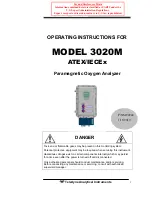
1864-1644 Positive Polarity Megohmmeter
APPLICATIONS
15
Dielectric absorption (dipole and interfacial polariza-
tion) is present in many capacitors and insulators,
especially those with a laminated structure. When
voltage is applied to such material, the charge slowly
diffuses throughout the volume and several minutes,
hours, or even days, are required for equilibrium in
order to make the charging current small compared
with the true leakage current. A measure of this ef-
fect, called the Polarization Index, is the ratio of the
resistance measured after 10 minutes of charging to
that measured after 1 minute of charging. Often, the
measured resistance after 1 minute of charging is
called the insulation resistance, even though charg-
ing current may be much larger than the true leakage
current. (Some capacitor speci
fi
cations say less than
2 minutes).
4.3.3 Measurement Time Constant
When the function switch is set from the
CHARGE
position to the
MEASURE
position, the standard
resistor is placed in series with the unknown ca-
pacitor. If the supply voltage is
fi
xed, the capacitor
must discharge by a voltage equal to that across the
voltmeter at its
fi
nal reading. The time constant for
this discharge would be C
X
R
s
. Because 80% of the
output voltage is fed back to the supply, this time
constant is reduced by a factor of 5. As a result, the
time necessary for an indication, assuming an ideal
capacitor, depends on this time constant or that of
the meter movement, whichever is longer.
Figure 4.2 Basic megohmmeter circuit
4.3.4 Discharge Time
With the function switch set at
DISCHARGE
, the
UNKNOWN
terminals are connected through 470
Ω
and the discharge time is approximately
0.0005 x C
μ
s, where C is in
μ
F. The red
DANGER
light is turned off by the function switch, so that the
capacitor might be charged even after the light is
extinguished. However, the discharge time is so short
that this is not a practical consideration, except for
capacitors greater than 100
μ
F.
Capacitors with high dielectric absorption (paragraph
4.3.2) can have a residual charge even after they are
shunted and must be repeatedly shunted to be com-
pletely discharged. Usually this "voltage recovery" is
only a few percent (i.e., 3%) of the original applied
voltage and, therefore, not dangerous to the operator,
but it can cause damage to sensitive circuit elements.
4.3.5 Large Capacitors, Very High
Resistance
Measuring insulation resistance of large capacitors
that have very low leakage is dif
fi
cult by any method.
Considering the basic circuit of Figure 4.2, if R
S
is
high, the R
S
C
X
time constant can become very long
on the high resistance ranges if C
X
is large. If R
S
is
low, the voltmeter must be very sensitive for a given
leakage resistance range and, therefore, the sup-
ply voltage (E) must be extremely stable to avoid
large meter
fl
uctuations. The design of the 1864 is
a compromise between these factors. Measurements
become dif
fi
cult when the R
S
C
X
product is 10
6
, even
under ideal conditions. This can be calculated as (C
X
in
μ
F) x (R
S
in M
Ω
)
or (C
X
in F) x (R
S
in
Ω
). Table
4.1 contains values for R
S
Measurements can be unsatisfactory even below this
value for an R
S
C
X
product for several reasons:
Summary of Contents for 1864-1644
Page 16: ...INTRODUCTION 1864 1644 Positive Polarity Megohmmeter 6 This page intentionally left blank...
Page 22: ...OPERATION 1864 1644 Positive Polarity Megohmmeter 12 This page intentionally left blank...
Page 28: ...APPLICATIONS 1864 1644 Positive Polarity Megohmmeter 18 This page intentionally left blank...
Page 40: ...1864 1644 Positive Polarity Megohmmeter 30 PARTS LIST AND DIAGRAMS...
Page 46: ...1864 1644 Positive Polarity Megohmmeter 36 PARTS LIST AND DIAGRAMS...















































